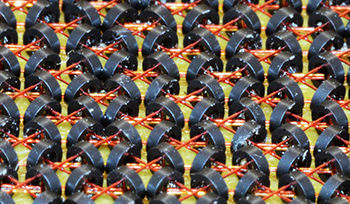- Shmoocon 2016 Videos (Internet Archive) — videos of the talks from an astonishingly good security conference.
- TipTalk — Samsung watchstrap that is the smart device … put your finger in your ear to hear the call. You had me at put my finger in my ear. (via WaPo)
- Ecorithms — Leslie Valiant at Harvard broadened the concept of an algorithm into an “ecorithm,” which is a learning algorithm that “runs” on any system capable of interacting with its physical environment. Algorithms apply to computational systems, but ecorithms can apply to biological organisms or entire species. The concept draws a computational equivalence between the way that individuals learn and the way that entire ecosystems evolve. In both cases, ecorithms describe adaptive behavior in a mechanistic way.
- Dataflow/Beam vs Spark (Google Cloud) — To highlight the distinguishing features of the Dataflow model, we’ll be comparing code side-by-side with Spark code snippets. Spark has had a huge and positive impact on the industry thanks to doing a number of things much better than other systems had done before. But Dataflow holds distinct advantages in programming model flexibility, power, and expressiveness, particularly in the out-of-order processing and real-time session management arenas.
"iot" entries


Four short links: 4 February 2016
Shmoocon Video, Smart Watchstrap, Generalizing Learning, and Dataflow vs Spark


Four short links: 2 February 2016
Fourth Industrial Revolution, Agent System, Evidence-Based Programming, and Deep Learning Service
- This is Not the Fourth Industrial Revolution (Slate) — the phrase “the fourth Industrial Revolution” has been around for more than 75 years. It first came into popular use in 1940.
- Huginn — MIT-licensed system for building agents that perform automated tasks for you online. They can read the Web, watch for events, and take actions on your behalf. Huginn’s Agents create and consume events, propagating them along a directed graph. Think of it as a hackable Yahoo! Pipes plus IFTTT on your own server.
- Evidence-Oriented Programming — design programming language syntax and features based on what research shows works. They tested Perl and Java, found apparently not detectably easier to use for novices than a language that my student at the time, Susanna Kiwala (formerly Siebert), created by essentially rolling dice and picking (ridiculous) symbols at random.
- Deep Detect — open source deep learning service.

Matthew Berggren on making electronics accessible
The O’Reilly Hardware Podcast: Better ways to design electronics.
Subscribe to the O’Reilly Hardware Podcast for insight and analysis about the Internet of Things and the worlds of hardware, software, and manufacturing.
In our new episode of the Hardware Podcast, David Cranor and I talk with Matthew Berggren, who at the time the interview was conducted last December was senior director of product at Supplyframe. (Berggren is now director of Autodesk Circuits at Autodesk.)
Our discussion focuses on the need for abstracted modules and better metadata in electronics. Berggren gets to the root of it here:
There are 30 software developers for every hardware engineer in the world. That’s not only a tremendous bottleneck, but if you accept the premise that the next generation of products are going to be some hybrid of hardware and software—and really, hardware is the means to interact with the real world, and I want to write software applications that will interact with the real world—then there is this massive blue ocean out there that should present tremendous opportunity to semiconductor manufacturers, or anyone else who wants to get into that space.

Roger Chen on hardware and robotics startups
The O’Reilly Hardware Podcast: Hardware from the venture capitalist’s point of view.
Subscribe to the O’Reilly Hardware Podcast for insight and analysis about the Internet of Things and the worlds of hardware, software, and manufacturing.
In this new episode of the Hardware Podcast, David Cranor and I talk with Roger Chen, formerly a principal at O’Reilly AlphaTech Ventures, O’Reilly Media’s sister VC firm.
Discussion points:
- Chen’s perspective as an investor on companies that are creating 3D robotics, drones, and satellites
- The Maker movement’s impact on the hardware startups
- Etsy’s influence on the new hardware movement
- Trends in robotics, and the outlook for robotics startups


Four short links: 11 January 2016
Productivity Mystery, Detecting Bullshit, Updating Cars, and Accountable Algorithms
- Why Americans Can’t Stop Working (The Atlantic) — summary of a paywalled economics paper on the mystery of increasing productivity yet increasing length of the work week. (via BoingBoing)
- On the Reception and Detection of Pseudo-Profound Bullshit (PDF) — These results support the idea that some people are more receptive to this type of bullshit and that detecting it is not merely a matter of indiscriminate skepticism but rather a discernment of deceptive vagueness in otherwise impressive sounding claims. (via Rowan Crawford)
- Tesla Model S Can Now Drive Without You (TechCrunch) — the upside of the Internet of Things is that objects get smarter while you sleep. (In fairness, they can also be pwned by Ukrainian teenagers while you sleep.)
- Replacing Judgement with Algorithms (Bruce Schneier) — We can get the benefits of automatic algorithmic systems while avoiding the dangers. It’s not even hard. Transparency and oversight with accountability.


Four short links: 28 December 2015
Bitcoin Software Choke, IoT Chokes, Dynabook History, and Fault Tree Analysis
- Core Bitcoin Devs Leave — According to a press release put out by Company 0 LLC, formed by former bitcoin developers, there are a few external entities that fund the actual development of the bitcoin cryptocurrency, forming a power-group that is in sole command of the direction the currency takes. These developers say that this group limits outside input in the currency’s governance, cherry-picks only options favorable for their own interests, and generally ignores the developers’ and community’s best interests.
- Internet of Proprietary Things — wonderfully accessible list of things we don’t have: Because companies can enforce anti-competitive behavior this way, there’s a litany of things that just don’t exist, even though they would make life easier for consumers in significant ways. You can’t have custom software for your cochlear implant, or your programmable thermostat, or your computer-enabled Barbie doll. An auto-repair shop can’t design a better diagnostic system that interfaces with a car’s computers. Capturing all the value you create, versus creating more value than you capture.
- Tracing the Dynabook — a historical study of the Dynabook project and vision, which began as a blue-sky project to define personal and educational computing at Xerox PARC in the 1970s. It traces the idea through the three intervening decades, noting the transformations that occur as the vision and its artifacts meet varying contexts. (via Bret Victor)
- Fault Tree Analysis (FTA): Concepts and Applications (PDF) — 194 slides from NASA. (via Mara Tam)

Joe Biron on IoT platforms
The O’Reilly Hardware Podcast: Building systems to get the most from connected devices.
Subscribe to the O’Reilly Hardware Podcast for insight and analysis about the Internet of Things and the worlds of hardware, software, and manufacturing.
This episode of the Hardware Podcast features my second discussion with Joe Biron, VP of IoT technology at ThingWorx, a PTC business that offers a platform for rapid deployment of Internet of Things applications.
Discussion points:
- How IoT platforms provide the functionality that enables advanced capabilities for IoT products
- The common architecture of properties, services, and events
- How to future-proof an embedded application
- Platforms for industrial versus consumer devices
- The potential for products that can update their own behavior
- Embracing—or avoiding—smartphone creep, in which functions once performed by specialized hardware are taken over by a phone


Four short links: 17 December 2015
Structured Image Concepts, Google's SDN, Lightbulb DeDRMing, and EFF SF
- Visual Genome — a data set, a knowledge base, an ongoing effort to connect structured image concepts to language.
- Google’s Software Defined Networking — [What was the biggest risk you faced rolling out the network? …] we were breaking the fate-sharing principle—which is to say we were putting ourselves in a situation where either the controller could fail without the switch failing, or the switch could fail without the controller failing. That generally leads to big problems in distributed computing, as many people learned the hard way once remote procedure calls became a dominant paradigm.
- Philips Backtrack on Lightbulb DRM — In view of the sentiment expressed by our customers, we have decided to reverse the software upgrade so that lights from other brands continue to work as they did before with the Philips Hue system.
- Pwning Tomorrow — EFF Publishes SF Anthology. You can expect liberties and freedoms to feature.

Mengmeng Chen on demystifying manufacturing
The O’Reilly Hardware Podcast: Making manufacturing accessible.
Subscribe to the O’Reilly Hardware Podcast for insight and analysis about the Internet of Things and the worlds of hardware, software, and manufacturing.
In this episode of the Hardware Podcast, we talk with Mengmeng Chen, head of U.S. operations at Seeed Studio.
Discussion points:
- Chen’s work on—and thoughts about—the Pop-up Factory, a production line that manufactured connected devices on the floor of the Solid 2015 conference
- Ways to start manufacturing in Shenzhen without a gigantic first order
- Seeed Studio’s “Open Parts Library,” a standard library of approximately 1,200 parts that can be assembled quickly and inexpensively
- Differences between the component supply chains in the U.S. and China
- Seeed’s Wio Link Kickstarter campaign


Four short links: 15 December 2015
Barbie Broken, JSON Database, Lightbulb DRM, and Graph Database
- Crypto is Hard says Hello Barbie — We discovered several issues with the Hello Barbie app including: it utilizes an authentication credential that can be re-used by attackers; it connects a mobile device to any unsecured Wi-Fi network if it has “Barbie” in the name; it shipped with unused code that serves no function but increases the overall attack surface. On the server side, we also discovered: client certificate authentication credentials can be used outside of the app by attackers to probe any of the Hello Barbie cloud servers; the ToyTalk server domain was on a cloud infrastructure susceptible to the POODLE attack. (via Ars Technica)
- Kinto — Mozilla’s open source lightweight JSON storage service with synchronisation and sharing abilities. It is meant to be easy to use and easy to self-host.
- Philips Blocks 3rd Party Lightbulbs — DRM for light fixtures. cf @internetofsh*t
- gaffer — GCHQ-released open source graph database. …a framework that makes it easy to store large-scale graphs in which the nodes and edges have statistics such as counts, histograms, and sketches. These statistics summarise the properties of the nodes and edges over time windows, and they can be dynamically updated over time. Gaffer is a graph database, rather than a graph processing system. It is optimised for retrieving data on nodes of interest. IHNJH,IJLTS “nodes of interest.”



